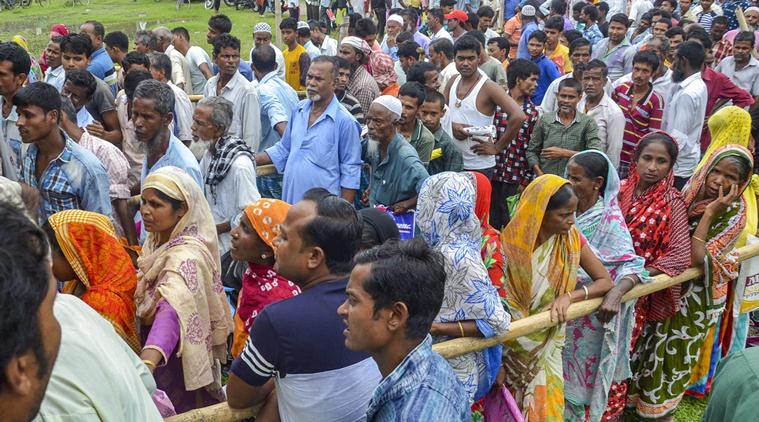
As the July 31 deadline for the Supreme Court-monitored NRC (National Register of Citizens) in Assam approaches, the faultlines in the discourse around it have widened. Some of the descriptions of the exercise ignore how its history dates back a century, and how that history continues to mould the present. The basic issue of weeding out infiltrators and preserving racial and ethnic identity is being drowned by confused concerns over the rights of refugees and a religious exodus. These accusations are false: The NRC refuses to touch refugees and only filters the infiltrators that have secured access to the state’s resources purely as a vote-bank. Given the exercise is Supreme Court monitored — the Court is ultimate guarantor of fundamental rights — any misgivings about a Rohingya-like situation in Assam must be ignored.
nrcThe British devised the “Line System” in 1916 and implemented it in 1920 in Assam wherein the specified areas were demarcated for Muslim immigrants and indigenous people. The immigrants were not allowed to settle in areas belonging to indigenous people of Assam.
C S Mullan, Superintendent of the 1931 Census highlighted the impact of immigrants on indigenous people of Assam. He pointed out that such an influx is akin to eliminating the Assamese race and culture at a greater pace than Burmese invasion century years ago. According to him, immigrants had already conquered Nowgong district, Darrang district and the Barpeta subdivisions were to be invaded. The immigration issue later formed the bedrock of the Pakistan movement in Assam. By 1937, Muslim League leaders propagated a theory that political power depended on population. This became even more prominent after the League’s 1940 Lahore resolution calling for the creation of Pakistan. Soon after, leaflets titled “Muslims of Assam, Unite” became rampant.
Lord Wavell, British Viceroy of India, during his 1943 visit to Assam said, “the chief political problem in Assam was the desire of the Muslim Ministers to increase the immigrant population into the uncultivated Government lands under the slogan of Grow More Food, but what they were really after was Grow More Muslims.” Further, a tripartite agreement between Government of Assam and the Muslim League in 1945 gave the former the rights to evict illegal immigrants who had migrated to the Assam province after 1938.
Assam bore the brunt of pre-Partition violence as well — Maulana Bashani (Muslim-League MLA from Dhubri South) called for immigrants to undertake jihad against the Congress-led Bordoloi government. A telegram from Bordoloi, the Premier of Assam, to Sardar Patel on March 19, 1947, read: “Assam situation serious, causing govt Great anxiety. Assam Muslim League and Bengali Muslim Leaders planning invasion of Assam by organised volunteers from Bengal. Many immigrants Muslim entered in Assam… Clash inevitable as tension continues.” When the results of the referendum in Muslim-majority Sylhet District were in favour of joining East Pakistan, Assam found itself in a comfortable situation. Bordoloi told Patel on February 18, 1948, that giving the Bengali district of Sylhet and a portion of Cachar from Assam to East Pakistan is “a consummation to which the Assamese people are looking forward for the last 70 years”.
The Asom Jatiya Mahasabha, which led the Assamese cause, published a statement the following statement in The Shillong Times on August 27, 1947: “With Sylhet joining Pakistan, Assam has grown smaller in area but attained greater homogeneity which has prompted Assam to be free and sovereign.”
Soon after Independence, the Nehru-Liaquat Pact of 1951 protected the rights of minorities of both India and Pakistan. The immigrant Muslims who had left Assam for East Pakistan returned due to the pact. However, they were not part of the 1951 census and the Assam NRC that was prepared that year.
In the next decade, the pogrom in East Pakistan against the Bengalis led to an increase in migration. This peaked at the time of the liberation of Bangladesh from Pakistan in 1971. Then, as per the Indira Gandhi-Mujibur Rahman Pact of 1972, all refugees who entered India before March 25, 1971, were allowed to stay in India.
By 1979, the monumental increase in the number of voters, 45,000 of whom were foreigners in a by-election in Assam, lead to birth of the Assam Movement. The movement demanded the deportation of foreigners and the deletion of their names from the electoral roll. The Assam Accord signed between the Rajiv Gandhi government and student leaders of Assam movement in 1985, says: “Foreigners who came to Assam on or after March 25, 1971, shall continue to be detected, deleted and practical steps shall be taken to expel such foreigners”.
The 2009 PIL in the Supreme Court filed by an Assamese NGO sought directions from the Court to delete the names of 41 lakh foreigners from the voters list on the pretext of Assam Accord and update the 1951 NRC accordingly. Since 2015, the process is court-monitored.
These 100 years, if anything, illustrate that Assam’s struggle isn’t new, and this exercise is not unfamiliar. The reasons behind NRC are same, as are the aspirations of the people whose will mandates it. Beyond the politics, polarisation and promises, for the first time, India is dissuading the nourishment of vote-banks at the expense of the state’s resources.